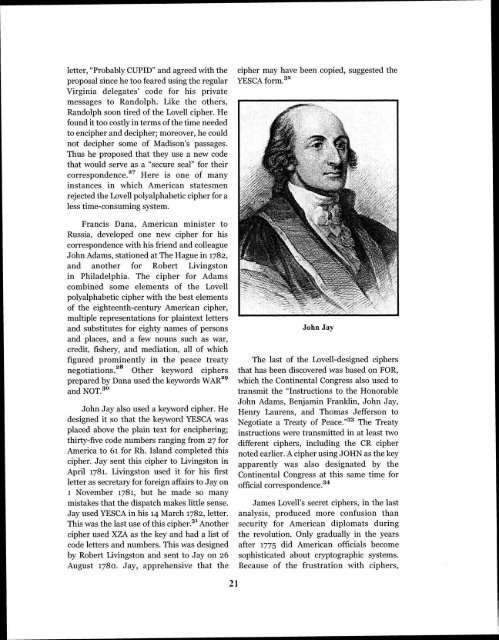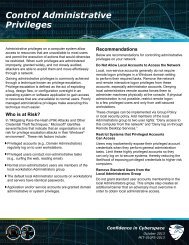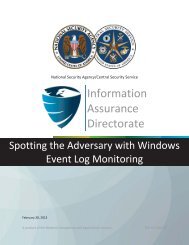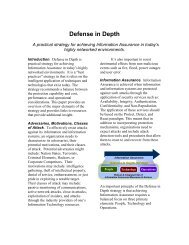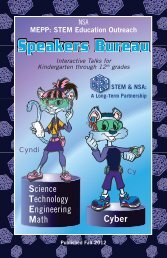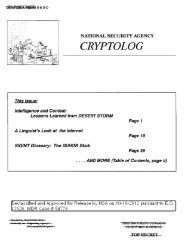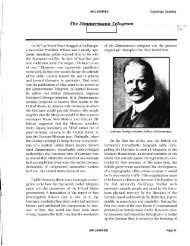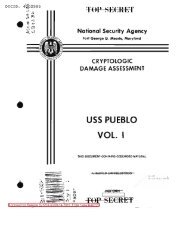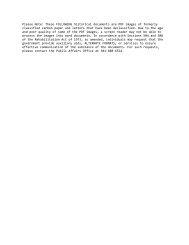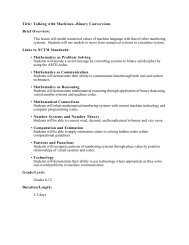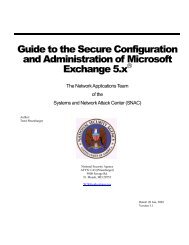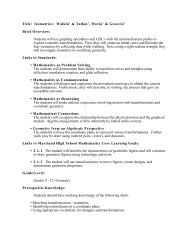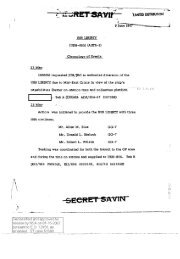Scanned Document - National Security Agency
Scanned Document - National Security Agency
Scanned Document - National Security Agency
You also want an ePaper? Increase the reach of your titles
YUMPU automatically turns print PDFs into web optimized ePapers that Google loves.
letter, "Probably CUPID" and agreed with the<br />
proposal since he too feared using the regular<br />
Virginia delegates' code for his private<br />
messages to Randolph. Like the others,<br />
Randolph soon tired of the Lovell cipher. He<br />
found it too costly in terms of the time needed<br />
to encipher and decipher; moreover, he could<br />
not decipher some of Madison's passages.<br />
Thus he proposed that they use a new code<br />
that would serve as a "secure seal" for their<br />
c~rres~ondence.~' Here is one of many<br />
instances in which American statesmen<br />
rejected the Lovell polyalphabetic cipher for a<br />
less time-consuming system.<br />
Francis Dana, American minister to<br />
Russia, developed one new cipher for his<br />
correspondence with his friend and colleague<br />
John Adams, stationed at The Hague in 1782,<br />
and another for Robert Livingston<br />
in Philadelphia. The cipher for Adams<br />
combined some elements of the Lovell<br />
polyalphabetic cipher with the best elements<br />
of the eighteenth-century American cipher,<br />
multiple representations for plaintext letters<br />
and substitutes for eighty names of persons<br />
and places, and a few nouns such as war,<br />
credit, fishery, and mediation, all of which<br />
figured prominently in the peace treaty<br />
negotiations." Other keyword ciphers<br />
prepared by Dana used the keywords MTAR'~<br />
and NOT.^^<br />
John Jay also used a keyword cipher. He<br />
designed it so that the keyword YESCA was<br />
placed above the plain text for enciphering;<br />
thirty-five code numbers ranging from 27 for<br />
America to 61 for Rh. Island completed this<br />
cipher. Jay sent this cipher to Livingston in<br />
April 1781. Livingston used it for his first<br />
letter as secretary for foreign affairs to Jay on<br />
1 November 1781, but he made so many<br />
mistakes that the dispatch makes little sense.<br />
Jay used YESCA in his 14 March 1782, letter.<br />
This was the last use of this cipher.31 not her<br />
cipher used XZA as the key and had a list of<br />
code letters and numbers. This was designed<br />
by Robert Livingston and sent to Jay on 26<br />
August 1780. Jay, apprehensive that the<br />
cipher may have been copied, suggested the<br />
YESCA form.32<br />
John Jay<br />
The last of the Lovell-designed ciphers<br />
that has been discovered was based on FOR,<br />
which the Continental Congress also used to<br />
transmit the "Instructions to the Honorable<br />
John Adams, Benjamin Franklin, John Jay,<br />
Henry Laurens, and Thomas Jefferson to<br />
Negotiate a Treaty of peace."" The Treaty<br />
instructions were transmitted in at least two<br />
different ciphers, including the CR cipher<br />
noted earlier. A cipher using JOHN as the key<br />
apparently was also designated by the<br />
Continental Congress at this same time for<br />
official c~rres~ondence.~~<br />
James Lovell's secret ciphers, in the last<br />
analysis, produced more confusion than<br />
security for American diplomats during<br />
the revolution. Only gradually in the years<br />
after 1775 did American officials become<br />
sophisticated about cryptographic systems.<br />
Because of the frustration with ciphers,


